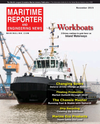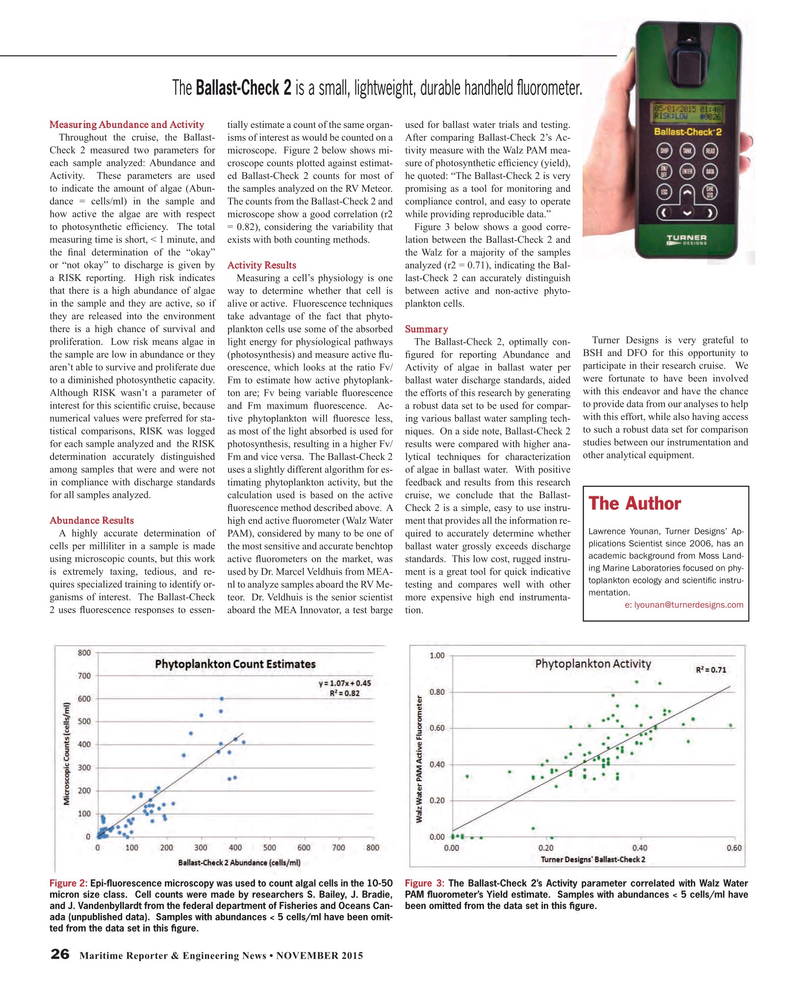
Page 26: of Maritime Reporter Magazine (November 2015)
Workboat Edition
Read this page in Pdf, Flash or Html5 edition of November 2015 Maritime Reporter Magazine
The Ballast-Check 2 is a small, lightweight, durable handheld ? uorometer.
Measuring Abundance and Activity tially estimate a count of the same organ- used for ballast water trials and testing.
Throughout the cruise, the Ballast- isms of interest as would be counted on a After comparing Ballast-Check 2’s Ac-
Check 2 measured two parameters for microscope. Figure 2 below shows mi- tivity measure with the Walz PAM mea- each sample analyzed: Abundance and croscope counts plotted against estimat- sure of photosynthetic ef? ciency (yield),
Activity. These parameters are used ed Ballast-Check 2 counts for most of he quoted: “The Ballast-Check 2 is very to indicate the amount of algae (Abun- the samples analyzed on the RV Meteor. promising as a tool for monitoring and dance = cells/ml) in the sample and The counts from the Ballast-Check 2 and compliance control, and easy to operate how active the algae are with respect microscope show a good correlation (r2 while providing reproducible data.” to photosynthetic ef? ciency. The total = 0.82), considering the variability that Figure 3 below shows a good corre- measuring time is short, < 1 minute, and exists with both counting methods. lation between the Ballast-Check 2 and the ? nal determination of the “okay” the Walz for a majority of the samples or “not okay” to discharge is given by Activity Results analyzed (r2 = 0.71), indicating the Bal- a RISK reporting. High risk indicates Measuring a cell’s physiology is one last-Check 2 can accurately distinguish that there is a high abundance of algae way to determine whether that cell is between active and non-active phyto- in the sample and they are active, so if alive or active. Fluorescence techniques plankton cells. they are released into the environment take advantage of the fact that phyto- there is a high chance of survival and plankton cells use some of the absorbed Summary
Turner Designs is very grateful to proliferation. Low risk means algae in light energy for physiological pathways The Ballast-Check 2, optimally con- the sample are low in abundance or they (photosynthesis) and measure active ? u- ? gured for reporting Abundance and BSH and DFO for this opportunity to aren’t able to survive and proliferate due orescence, which looks at the ratio Fv/ Activity of algae in ballast water per participate in their research cruise. We to a diminished photosynthetic capacity. Fm to estimate how active phytoplank- ballast water discharge standards, aided were fortunate to have been involved
Although RISK wasn’t a parameter of ton are; Fv being variable ? uorescence the efforts of this research by generating with this endeavor and have the chance to provide data from our analyses to help interest for this scienti? c cruise, because and Fm maximum ? uorescence. Ac- a robust data set to be used for compar- with this effort, while also having access numerical values were preferred for sta- tive phytoplankton will ? uoresce less, ing various ballast water sampling tech- tistical comparisons, RISK was logged as most of the light absorbed is used for niques. On a side note, Ballast-Check 2 to such a robust data set for comparison studies between our instrumentation and for each sample analyzed and the RISK photosynthesis, resulting in a higher Fv/ results were compared with higher ana- determination accurately distinguished Fm and vice versa. The Ballast-Check 2 lytical techniques for characterization other analytical equipment. among samples that were and were not uses a slightly different algorithm for es- of algae in ballast water. With positive in compliance with discharge standards timating phytoplankton activity, but the feedback and results from this research for all samples analyzed. calculation used is based on the active cruise, we conclude that the Ballast-
The Author ? uorescence method described above. A Check 2 is a simple, easy to use instru-
Abundance Results high end active ? uorometer (Walz Water ment that provides all the information re-
Lawrence Younan, Turner Designs’ Ap-
A highly accurate determination of PAM), considered by many to be one of quired to accurately determine whether plications Scientist since 2006, has an cells per milliliter in a sample is made the most sensitive and accurate benchtop ballast water grossly exceeds discharge academic background from Moss Land- using microscopic counts, but this work active ? uorometers on the market, was standards. This low cost, rugged instru- ing Marine Laboratories focused on phy- is extremely taxing, tedious, and re- used by Dr. Marcel Veldhuis from MEA- ment is a great tool for quick indicative toplankton ecology and scienti? c instru- quires specialized training to identify or- nl to analyze samples aboard the RV Me- testing and compares well with other mentation. ganisms of interest. The Ballast-Check teor. Dr. Veldhuis is the senior scientist more expensive high end instrumenta- e: [email protected] 2 uses ? uorescence responses to essen- aboard the MEA Innovator, a test barge tion.
Figure 2: Epi-? uorescence microscopy was used to count algal cells in the 10-50 Figure 3: The Ballast-Check 2’s Activity parameter correlated with Walz Water micron size class. Cell counts were made by researchers S. Bailey, J. Bradie, PAM ? uorometer’s Yield estimate. Samples with abundances < 5 cells/ml have and J. Vandenbyllardt from the federal department of Fisheries and Oceans Can- been omitted from the data set in this ? gure. ada (unpublished data). Samples with abundances < 5 cells/ml have been omit- ted from the data set in this ? gure. 26 Maritime Reporter & Engineering News • NOVEMBER 2015
MR #11 (26-33).indd 26 10/30/2015 10:05:16 AM

 25
25

 27
27
